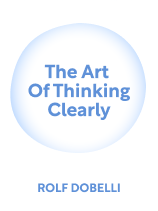

This article is an excerpt from the Shortform book guide to "The Art of Thinking Clearly" by Rolf Dobelli. Shortform has the world's best summaries and analyses of books you should be reading.
Like this article? Sign up for a free trial here .
What are some of the most common logical fallacies? Why do these fallacies occur?
There are two main kinds of thinking: fast and instinctive, and slow and logical. Both play important roles, but both cause logical fallacies when used in the wrong situation.
Here are some of the most common logical fallacies that come from using the wrong kind of thinking.
The Conjunction Fallacy
The conjunction fallacy—the tendency to prefer a plausible story to a probable one—is one of the most common logical fallacies. When a story makes sense to you, you’re likely to believe it even if the true probability of it occurring is low.
For example, consider a girl named Katrina who loves musicals. Now consider these statements:
- Katrina performs on stage.
- Katrina performs on stage in a musical.
Many people pick the second option as most likely because it makes a better story: Katrina loves musicals, so she’d perform in a musical. However, the first option is actually more likely in terms of probability because it’s broader: It has just one condition (Katrina being on stage) rather than two (Katrina being on stage and in a musical).
The conjunction fallacy occurs when you use fast thinking instead of slow, Dobelli says. While your logical brain is still calculating the probability of an event, your instinctive thought process makes connections to explain why the event might occur. The connections it finds often form a plausible story, so you accept the instinctive connection rather than waiting for the logical probability.
The Affect Heuristic
Dobelli says the affect heuristic is a mental shortcut in which your brain makes rapid subconscious judgments of like or dislike. These “affects” influence your risk-benefit analyses: If your immediate judgment is good, you’ll focus on the benefits of a situation, while if the affect is bad, you’ll focus on the risks.
(Shortform note: Heuristics like the affect heuristic aren’t necessarily negative. They keep your brain working efficiently and help you make decisions. The affect heuristic was particularly helpful to early humans because it quickly provides more data for risk analysis, and early humans faced regular life-threatening risks—for instance, being attacked by wild predators. However, the information required for a good risk-benefit analysis in modern times is too complex for the affect heuristic to assess adequately, especially when emotions are involved. Rather than being beneficial, the heuristic can lead you to make a risky decision merely because you’re excited or delay a good decision because you’re sad.)
Allowing affects to control your behavior is dangerous because they’re manipulatable, Dobelli warns. Images and situations alter people’s affects, changing the way you judge items or situations. For instance, marketers use cheerful pictures to give you a positive affect of their product.
(Shortform note: You might assume that only people have affects based on appearance, but any object can have them. Machines that look intimidating, like a nuclear power plant, make people wary even if their benefits outweigh their risks. On the other hand, people downplay the risks of enticing items, like a motorcycle, even though they’re extremely dangerous.)
Hyperbolic Discounting
Another incorrect use of cognition is hyperbolic discounting: the tendency to crave immediate gratification and the willingness to sacrifice an unreasonable amount of money, time, or effort for that immediacy. It’s difficult for people to wait for things, Dobelli says, a tendency that accelerates the closer you come to attaining gratification.
(Shortform note: While Dobelli doesn’t define it as such, this is an example of overused hot cognition and underused cold cognition. People who can delay gratification have better-developed prefrontal cortexes, the part of the brain that handles cold cognition. Thus, they delay gratification by using their prefrontal cortexes to engage cold cognition. Meanwhile, those with less developed prefrontal cortexes are more susceptible to the instinctual desire for instant gratification.)
Dobelli says this is an instinctive trait from times when humans were more animalistic, noting that animals display this trait too. Consider wolves, who eat almost half their body weight at once. They can’t delay gratification because they don’t know when they’ll have another meal. However, humans no longer need instant gratification to survive, so hyperbolic discounting just inspires bad decisions, like paying a high amount to get something quicker.

———End of Preview———
Like what you just read? Read the rest of the world's best book summary and analysis of Rolf Dobelli's "The Art of Thinking Clearly" at Shortform .
Here's what you'll find in our full The Art of Thinking Clearly summary :
- A detailed look at the most common logical fallacies that inhibit decision-making
- How to recognize and overcome these fallacies to make better decisions
- Why you value things for arbitrary reasons






